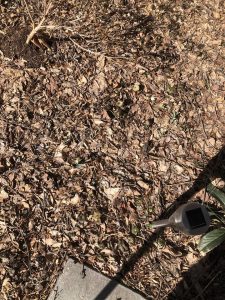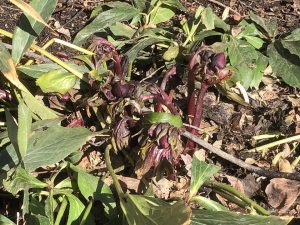Garden log: We still have a few cold days coming at the end of February, but it’s warming up enough, esp. when it’s sunny, that it’s very hard for me to resist starting to putter in the garden. There’s a little patch by my front door that I ended up raking clear yesterday, uncovering a mature hellebore.
You don’t need to do this, the raking! And in fact, the more eco-friendly option would be to just leave it alone, not disturbing any possible pollinator larvae, etc. Maybe someday, that’ll be how I garden entirely, as if we were in the wild — no one is raking away leaves in the woodland or prairie! I’m heading a little more that way every year, it seems.
But right now, I still do rake some of my beds clear, for various reasons. I let the leaves fall in autumn, and degrade there — the breakdown of leaf mould over ten years now has dramatically improved the clay soil in my garden, making it much easier to dig and plant in. But then I do rake it away in spring — we have enough leaves falling in my garden that in some places it makes a heavy, compacted layer, and that means my tiny bulbs can’t always push their way through. I love the thrill of uncovering a little emerging flowering beauty.
(I don’t compost right away — I rake them into a big leaf pile in a corner of the garden and let them be for a while longer. Some more pollinators may well emerge from there.)
For the hellebore, I raked around it with a small rake, then used gloved fingers to clear away the last of the dry leaves entangled. That left me with a lot of big, old green leaves, lots of flower buds in the center, and some new leaves starting. If the old leaves are raggedy and bothering you, you can trim them away; the new leaves will emerge in a few weeks. But I’m leaving mine for now, in the hopes that they’ll continue to soak up lots of sun, converting it to nutrients and growing a stronger plant overall. I may trim them away once the new leaves emerge fully, esp. if they’re looking shoddy by comparison.
Can you see that one tiny snowdrop that’s managed to push through the leaf mould? Once I raked away the thick layer, tons of other tiny shoots emerged. Soon that will be a nice big patch of snowdrops, to be followed by whatever other spring ephemeral bulbs I planted there. Probably some scilla, chionodoxa, reticulated iris, muscari, crocuses — classic early spring ephemeral bulbs.
I’ve just started learning more about native spring ephemerals. It can be confusing — when we talk about “native spring ephemerals”, it seems like we’re talking about plants (often not bulbs) that bloom anywhere from February to May. Whereas when we talk about “spring ephemeral bulbs”, we’re usually talking about early spring, February / March, the tiny little flowers that come before the daffodils and tulips start blooming.
From what I’ve seen, natives tend to be a little more expensive to buy, and a little slower to grow and get established. But if you’re interested in them, there are more and more showing up in local nurseries, and if people continue to buy them, they should become more readily available (and hopefully more affordable, as more growers invest in them?). I’ve started trying to add them into my garden, as my budget allows, so I hope that in future years, I’ll have more natives to show off. ![]()
One plus is that while you have to plant most bulbs in the fall, many of the native spring ephemerals can be planted in spring. New hellebores can also be planted in spring, to return year after year. Which means it’ll soon be time to start haunting the garden stores. Yes, I’m the obsessed plant lady who shows up in March, with eager eyes and grabby hands — “Are they in yet?” Maybe this year I’ll call first…







